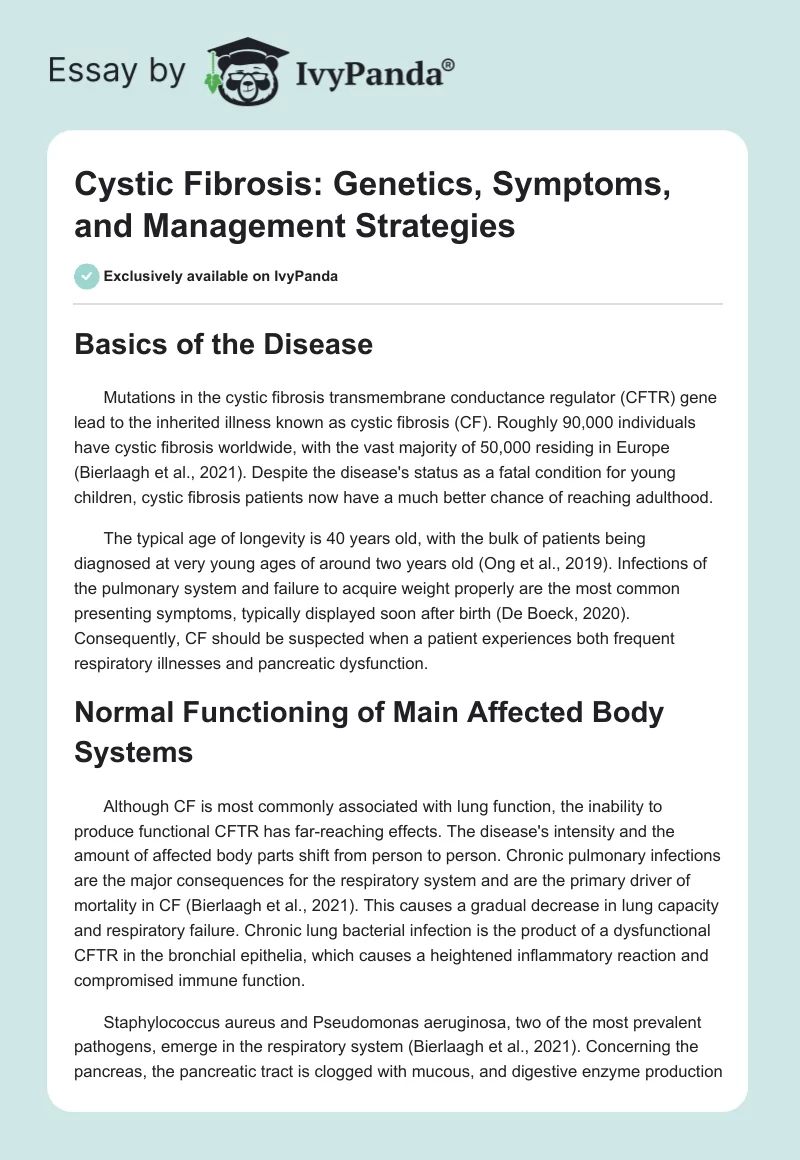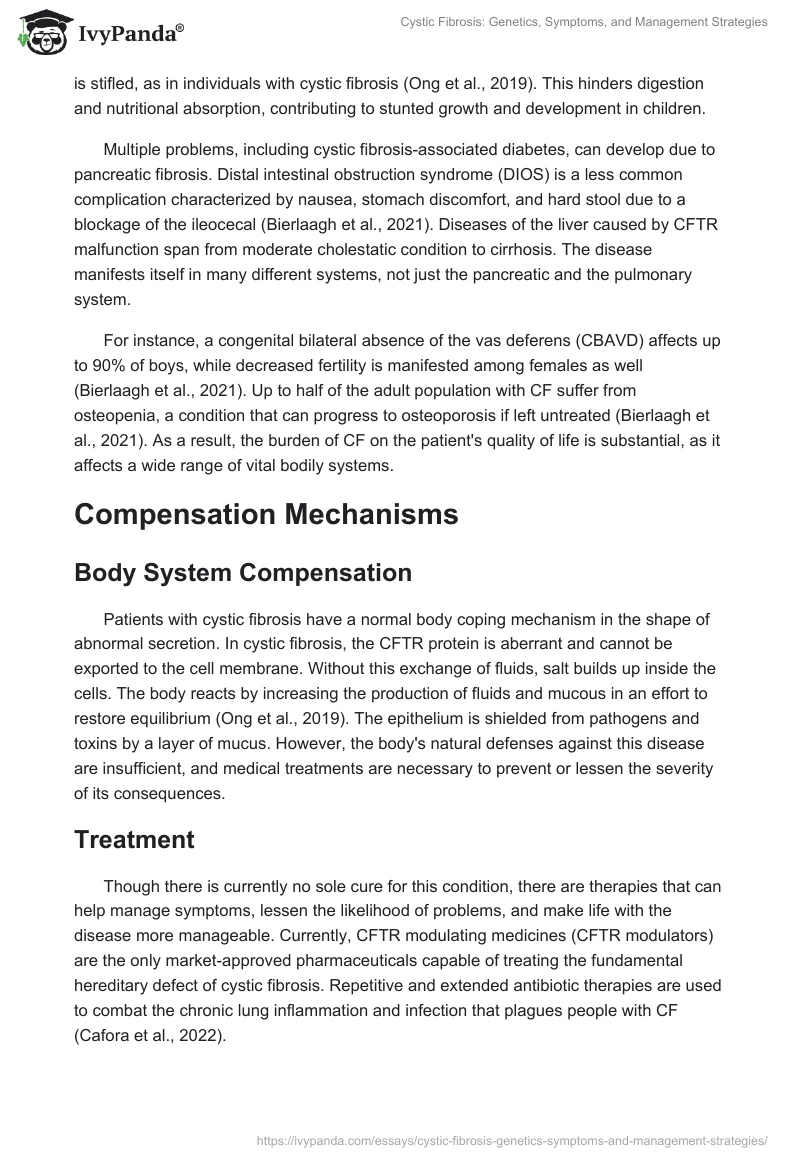Basics of the Disease
Mutations in the cystic fibrosis transmembrane conductance regulator (CFTR) gene lead to the inherited illness known as cystic fibrosis (CF). Roughly 90,000 individuals have cystic fibrosis worldwide, with the vast majority of 50,000 residing in Europe (Bierlaagh et al., 2021). Despite the disease’s status as a fatal condition for young children, cystic fibrosis patients now have a much better chance of reaching adulthood.
The typical age of longevity is 40 years old, with the bulk of patients being diagnosed at very young ages of around two years old (Ong et al., 2019). Infections of the pulmonary system and failure to acquire weight properly are the most common presenting symptoms, typically displayed soon after birth (De Boeck, 2020). Consequently, CF should be suspected when a patient experiences both frequent respiratory illnesses and pancreatic dysfunction.
Normal Functioning of Main Affected Body Systems
Although CF is most commonly associated with lung function, the inability to produce functional CFTR has far-reaching effects. The disease’s intensity and the amount of affected body parts shift from person to person. Chronic pulmonary infections are the major consequences for the respiratory system and are the primary driver of mortality in CF (Bierlaagh et al., 2021). This causes a gradual decrease in lung capacity and respiratory failure. Chronic lung bacterial infection is the product of a dysfunctional CFTR in the bronchial epithelia, which causes a heightened inflammatory reaction and compromised immune function.
Staphylococcus aureus and Pseudomonas aeruginosa, two of the most prevalent pathogens, emerge in the respiratory system (Bierlaagh et al., 2021). Concerning the pancreas, the pancreatic tract is clogged with mucous, and digestive enzyme production is stifled, as in individuals with cystic fibrosis (Ong et al., 2019). This hinders digestion and nutritional absorption, contributing to stunted growth and development in children.
Multiple problems, including cystic fibrosis-associated diabetes, can develop due to pancreatic fibrosis. Distal intestinal obstruction syndrome (DIOS) is a less common complication characterized by nausea, stomach discomfort, and hard stool due to a blockage of the ileocecal (Bierlaagh et al., 2021). Diseases of the liver caused by CFTR malfunction span from moderate cholestatic condition to cirrhosis. The disease manifests itself in many different systems, not just the pancreatic and the pulmonary system.
For instance, a congenital bilateral absence of the vas deferens (CBAVD) affects up to 90% of boys, while decreased fertility is manifested among females as well (Bierlaagh et al., 2021). Up to half of the adult population with CF suffer from osteopenia, a condition that can progress to osteoporosis if left untreated (Bierlaagh et al., 2021). As a result, the burden of CF on the patient’s quality of life is substantial, as it affects a wide range of vital bodily systems.
Compensation Mechanisms
Body System Compensation
Patients with cystic fibrosis have a normal body coping mechanism in the shape of abnormal secretion. In cystic fibrosis, the CFTR protein is aberrant and cannot be exported to the cell membrane. Without this exchange of fluids, salt builds up inside the cells. The body reacts by increasing the production of fluids and mucous in an effort to restore equilibrium (Ong et al., 2019). The epithelium is shielded from pathogens and toxins by a layer of mucus. However, the body’s natural defenses against this disease are insufficient, and medical treatments are necessary to prevent or lessen the severity of its consequences.
Treatment
Though there is currently no sole cure for this condition, there are therapies that can help manage symptoms, lessen the likelihood of problems, and make life with the disease more manageable. Currently, CFTR modulating medicines (CFTR modulators) are the only market-approved pharmaceuticals capable of treating the fundamental hereditary defect of cystic fibrosis. Repetitive and extended antibiotic therapies are used to combat the chronic lung inflammation and infection that plagues people with CF (Cafora et al., 2022).
Tezacaftor (TEZ), elexacaftor (ELX), and ivacaftor (IVA), all of which work by correcting the CFTR folding, are the most common paths of treatment. Clinical studies showed that such treatment improved lung capacity, body mass index, and overall quality of life in people with CF (Pallenberg et al., 2021). Cystic fibrosis patients, who previously had no options beyond symptomatic therapy, now have access to a variety of CFTR modulators that enhance life span as well as the quality of living.
Dietary Recommendations
Clinical results can be improved by adhering to specific nutritional guidelines for those with CF. Since fats are nutrient- and energy-dense, they are often suggested for individuals with CF. It is advised to consume both polyunsaturated and monounsaturated lipids, as well as other sources of a high-fat diet. Ingredients like these can be found in seafood, nuts, nut oils, seeds, and fat-rich greens (Kaminski et al., 2019). Further, the protein requirements of people with CF are up to twofold greater than those of the general community (Kaminski et al., 2019). Protein requirements are typically met by consuming a high-calorie meal for people with CF. Because of the sodium loss associated with CF, a high-salt diet is advised, especially in situations where sweating is likely (Kaminski et al., 2019).
Daily supplementation with a CF-specific multivitamin or a normal multivitamin containing extra amounts of the lipid-soluble vitamins A, D, E, and K is recommended for the vast majority of people with CF (Kaminski et al., 2019). Therefore, dietary control of CF remains an essential component of treatment due to the paramount significance of sustaining an appropriate nutritional state.
References
Bierlaagh, M., Muilwijk, D., Beekman, J. M., & Van Der Ent, C. K. (2021). A new era for people with cystic fibrosis. European Journal of Pediatrics, 180(9), 2731–2739. Web.
Cafora, M., Chanson, M., & Pistocchi, A. (2022). Restoring airway epithelial homeostasis in Cystic Fibrosis. Journal of Cystic Fibrosis, 22, 27-31. Web.
De Boeck, K. (2020). Cystic fibrosis in the year 2020: A disease with a new face. Acta Paediatrica, 109(5), 893–899. Web.
Kaminski, B., Goldsweig, B., Sidhaye, A., Blackman, S. M., Schindler, T., & Moran, A. (2019). Cystic fibrosis-related diabetes: Nutrition and growth considerations. Journal of Cystic Fibrosis, 18, S32–S37. Web.
Ong, V. Y. K., Mei, V., Cao, L., Lee, K., & Chung, E. C. (2019). Nanomedicine for cystic fibrosis. Journal of Laboratory Automation, 24(2), 169–180. Web.
Pallenberg, S., Junge, S., Ringshausen, F. C., Sauer-Heilborn, A., Hansen, G., Dittrich, A., Tümmler, B., & Nietert, M. (2021). CFTR modulation with elexacaftor-tezacaftor-ivacaftor in people with cystic fibrosis assessed by the β-adrenergic sweat rate assay. Journal of Cystic Fibrosis, 21(3), 442–447. Web.


